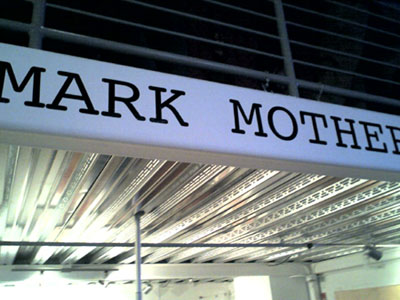Mark Mothersbaugh’s Postcard Diaries
Published on May 30th, 2008 in: Art, Current Faves, Issues, Music, Retrovirus, Reviews |By Adam McIntyre
Rabbit Hole Gallery, Atlanta GA
April 18, 2008
“Would you like to attend a Mark Mothersbaugh art exhibit?” This is a rhetorical question: it should be obvious to anyone who knows me what my answer would be. Mark Mothersbaugh’s art (in the media of visual, print, and live or recorded music) is so ingrained into my perception of pop culture that I can hardly notice one without thinking of the other.

Mothersbaugh is probably best known for his tenure with the band Devo, who began at Kent State as a sort of backlash against the Kent State Massacre; it seemed to Mothersbaugh and fellow Devo member Gerald Casale that human society was devolving. This theory led to proto-punk performances by college kids in ape and baby masks. The prize-winning recipe of Devo’s hit-making era depended on a bizarre regurgitation and absurd distortion of pop culture. Imagine the Twilight Zone episode where the horribly disfigured face being unbandaged resembles our own, and everyone else looks like monsters. In the Devo version, the horribly disfigured face might be a Ronald Regan mask, and all of the “normal” people might be cartoonish mutants, or perhaps identical 1950s TV cowboys.
In fact, the visual aspect of Devo has always been as essential to the experience as the music. Songs were made with high-impact videos in mind. Lately, Mark Mothersbaugh has made quite a big name for himself scoring films and television (even commercials), genres in which he has demonstrated not only technical proficiency but versatility. Pop culture now holds a reverent mirror up to Devo, a development which amuses them to no end. [Like the recent American Idol/McDonald’s Happy Meal Toy “New Wave Nigel.”—Ed.]
During Devo’s earlier world touring days, Mark Mothersbaugh began sending postcards from the road to friends and loved ones. He decorated the postcards either entirely from scratch or by creating a design over the existing print, which was text or art in itself. This allowed for both juxtaposition and commentary, and allowed the postcard to create its own atmosphere. Mothersbaugh also made his own stamps and followed his muse through various iconographic images. Imagine getting a postcard marked “POISON” with an evil clown on it, or perhaps an alien waving to you as its eyeballs fall out. The whole thing makes one feel as though these things are totally normal, and that it’s the viewer who might be going insane.
The art is presented as if these things have been found in America’s most twisted flea market, located between a bowling alley and a drive-in. The characters are salesmen, freshly morphed into man-dogs, or an imaginary gum wrapper comic character being bitten on the tongue by a vicious snake. The women represented in the postcards are often campy 1950s housewives, or naughty girls fellating cute creatures. Because these pieces utilize the shading and line conventions of a stamp, they display a style evocative of a more innocent time although twisted and perhaps sinister things are afoot.
But it’s not always referential of 50s wholesomeness-gone-awry or weird Midwestern Americana; in one painting, a huge lizard stands on two legs and eyes a beautiful Mughal building with a look that somberly seems to say, “Hm, that’s nice. Quite nice.” The title? “Godzilla Visits India.” It’s both hilarious and beautiful. One piece is a breathtaking illustration of a man on the ground clutching his stomach, his hat next to him. The title? “Mortally Wounded.”

Hawk Crow Duck Call
Edition of 3
Framed size: 23.75″ x 18.5″
Mothersbaugh does not generally attend his touring exhibits in person, but technology does allow him to work at the home base for Mutato (his scoring and visual art business) while conversing via web chat. Attendees at the Atlanta exhibit could enjoy complimentary drinks, cheese, and crackers, and sign up for the opportunity to have a webcam chat with the artist.
I pitied Mothersbaugh as the fellow before me was told several times that his time was up and to please leave, but his gushing and praise for Devo wouldn’t ebb: he was practically shouting requests and Devo-related slogans. I worried that the Q & A would be cut short after this incident but my “Hey man, how ya doing?” was matched with his cheerful, trademark “Greetings!” Mothersbaugh conceded that for some of his incredibly vivid backgrounds, he’s lately been doing them on a computer and printing them out before layering his characters over them. “Gaussian Blur it’s called, in Photoshop. Heard of it? Quite helpful.”
Then the sickness came over me, the compulsive need to ask about his other endeavors. I think the guy before me had infected the keyboard with some kind of fanboy fever. “One other thing. . . I wanted to know about your involvement with the next Wes Anderson film.” Every Wes Anderson film save the most recent one, The Darjeeling Limited, has featured a charmingly baroque soundtrack, courtesy of Mothersbaugh. “I have to be honest—I don’t actually know. We’re supposed to meet in Paris next month because Devo will be playing there and he’s there right now. I’m sure we’ll talk about it then.”
There you have it. Until we know more, you can rest easy knowing that no matter what, Mark Mothersbaugh will continue to create both musical and visual art, often but not always, at the same moment. On the way out of the clean and beautiful Rabbit Hole Gallery, my friend asked me another rhetorical question: “Did you have a good time?”
Time limit is exhausted. Please reload the CAPTCHA.